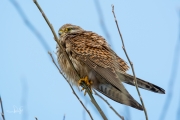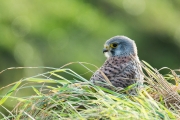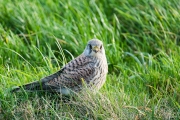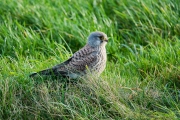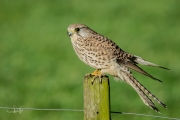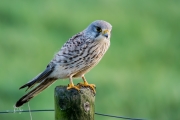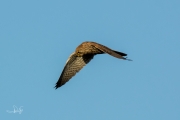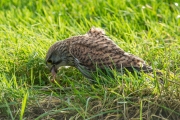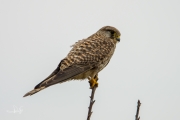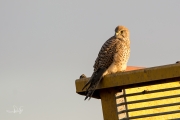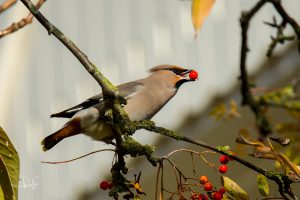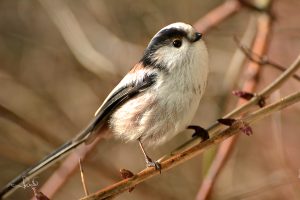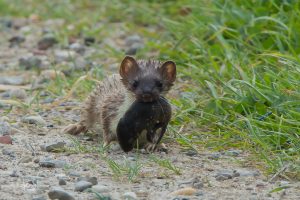This time we shine the spotlight on one of the prettiest (in my opinion) and most graceful (that too is personal) birds of prey of the Netherlands: the kestrel (Falco tinnunculus). Well known by many, I assume, because it’s a very common bird. Although this bird is currently experiencing a decline in numbers, the kestrel used to be the most common bird of prey in the Netherlands, nowadays it has to give its first place to the common buzzard (Buteo buteo). Since 1990 there has even been a steady decline in the number of breeding pairs of the kestrel. This bird that was once characteristic for the Dutch landscape is, like so many other bird species, at threat of disappearing here.
Nest boxes
This decline won’t be because of a lack of nesting sites. After all the typical half-open nest boxes on poles can be seen everywhere. The kestrel makes few demands. These nest boxes remind me of my childhood, when we had hung a nest box in the orchard in the neighborhood. We had a successful brood there several times. Especially the ringing of the youngsters was a special event for me as a young kid when you have such a small and vulnerable bird in your hands. Nowadays we have three nest boxes here in our current residence for a few years, but unfortunately this has not yet resulted in a successful brood. There are a couple of kestrels and there seems to be plenty to eat in the area, certainly because the kestrel is an opportunist. In addition to voles and mice, it also feeds on small birds, large insects and fat earthworms. Just look at one of the photos.
Hovering
The most characteristic of the kestrel is its hovering: hanging still in the air with its head in the wind, just moving its wings and the gaze looking straight down in search of prey. Hovering requires a lot of energy from the bird. So why does a kestrel actually do this? The reason is quite simple, a kestrel generally catches its preys on the ground and can only do this from a stationary position. Different from a peregrine falcon (Falco peregrinus), for example, that hits its prey in the air. Or from a hawk (Accipiter gentilis) or sparrow hawk (Accipiter nisus), species that chase and literally pick a bird out of the sky. A kestrel can’t do that. That is just how it has evolved. It must therefore be able to look down from a certain height to discover its prey. And in the absence of a high post the bird does this by hovering. Incidentally, a kestrel sometimes catches flying birds, but its preference is nevertheless with ground prey.
Literally praying
In Dutch, the hovering is also called “bidden”, which in English can be literally translated to praying. You may wonder where this term comes from. On one hand, a link is made to the moment of reflection that people take while praying before they eat. A hovering kestrel is also seen as a moment of peace and concentration before it hits its prey. On the other hand, they use the link to the English term for birds of prey. Pray is pronounced in the same way as prey. It could therefore also be a wrong translation from English and that seems to me the most credible explanation. By the way, the kestrel is certainly not the only bird that hovers before catching prey. The common buzzard also does this, just like its relative the rough-legged buzzard (Buteo lagopus), a rarity that you can encounter in the Netherlands in winter. But also the osprey (Pandion haliaetus), the kingfisher (Alcedo atthis) and the great grey shrike (Lanius excubitor) exhibit this behaviour. They all hover to catch their prey, albeit more briefly and not as frequently as the kestrel.
6 millimeters
Hovering is only possible when the wind blows. In real windless weather it is not possible for the kestrel to hover. Then it is forced to hunt in a different way, for example by hitting a bird out of the sky or still watching the immediate surroundings from a lookout post. When the kestrel hovers, its wings move faster or slower depending on the wind speed. It flies, as it were, at the same speed as the wind, but then against the wind. So that on balance it stays in the same place. It uses its tail as a brake. That is why you sometimes see that the bird has its wings still for a while, the wind speed is such that it is only slowed down by using its tail to stay in place. Pretty good, we humans need computers, ingenious machines and a lot of energy to achieve the same result in a helicopter for example. The kestrel even does this so cleverly that everything on that slender body moves during hovering, except its head. Scientific research has shown that its head moves at most 6 millimeters in all directions. This way it can stay focused on the prey on the ground.
Shrill sounding falcon
The kestrel’s name comes from the Middle English castrel and that is based at the Middle French crecerelle, from crecelle which means rattle and is related to the birds’ cry. In French the bird is called faucon crécerelle. The name kestrel for the bird was first used in the 15th century. Its scientific name Falco tinnunculus literally means shrill sounding falcon, which also refers to its sound, particular the sound kestrels produce during the mating season.
Magnificent bird, the kestrel. I really love it seeing them hover and mostly I wait to see if it was successful.
Sources:
This item was originally published in Dutch on September 25th 2017



